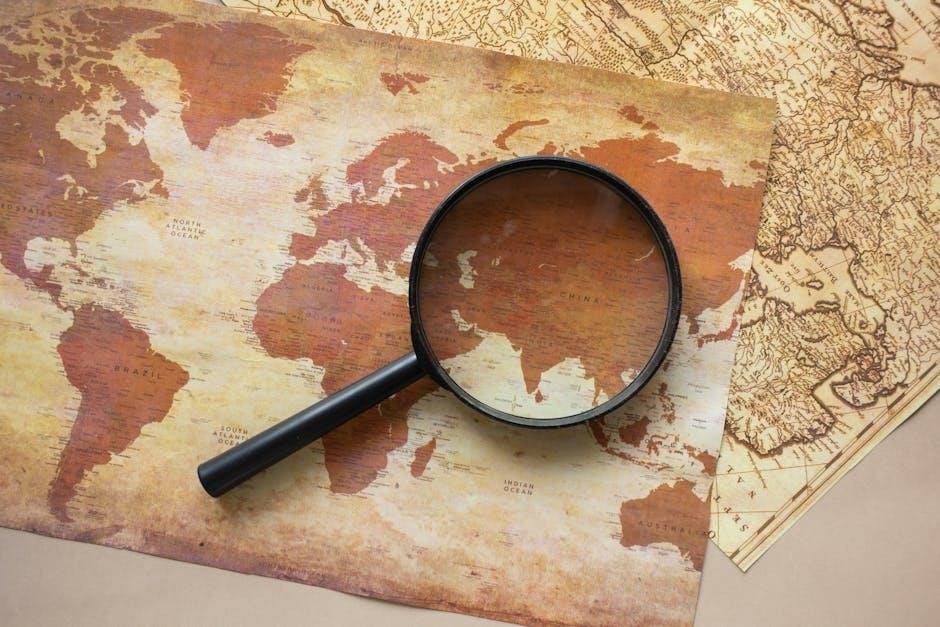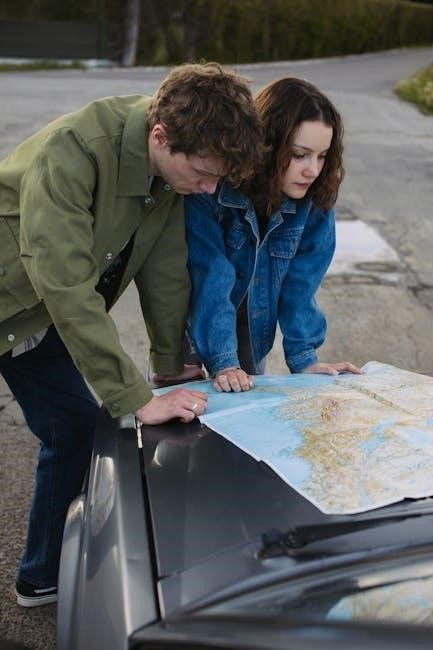15-minute radius maps are visual tools showing the area reachable from a specific point within 15 minutes․ They are created using mapping software or online tools․ These maps help in analyzing accessibility and convenience for various applications․ These maps are useful in different sectors․

Defining a 15-Minute Radius Map
A 15-minute radius map is a geographical representation illustrating the area accessible from a central location within a 15-minute timeframe․ This timeframe can be based on various modes of transport, including walking, cycling, driving, or public transportation․ The map uses a circle to visualize this area․ This is based on a chosen means of transportation․
Traditional radius maps use straight-line distances, whereas more advanced versions, known as isochrone maps, consider real-world travel conditions․ These factors incorporate road networks, traffic patterns, and transportation schedules․ Isochrone maps provide a more accurate depiction of reachable areas․ They are often used for urban planning, real estate analysis, and business location strategies․
The key element of a 15-minute radius map is to visualize the ease of access to amenities, services, and resources within a short commute․ This concept promotes walkable and bikeable neighborhoods, reducing reliance on cars and promoting sustainability․ The maps help stakeholders make informed decisions about resource placement․ They are helpful for stakeholders to analyse the community․
These maps can be created using various online tools and software, allowing for customization based on specific needs and data inputs․ They offer a straightforward way to evaluate location advantages and disadvantages․
Tools for Creating 15-Minute Radius Maps
Several online and software-based tools are available for creating 15-minute radius maps․ These tools allow users to define a central point and generate a map showing the area reachable within the specified time․ Some tools even account for different travel modes․
Online Radius Mapping Tools
Numerous online radius mapping tools offer convenient ways to visualize areas within a 15-minute radius․ These tools often provide user-friendly interfaces where you can input an address or click on a map to define the center point․ You can then specify the radius distance, typically in miles, kilometers, or travel time, to generate a circular area on the map․
Many of these tools allow you to customize the map’s appearance, such as changing the color or transparency of the radius area․ Some also offer the ability to save the generated map as an image or GeoJSON file for later use or sharing․ A great feature is that some can calculate travel time․
Popular online radius mapping tools include those that allow you to draw circles around a point on a map, measure distances, and even create travel time isochrones․ These tools often integrate with services like Google Maps, providing a familiar and intuitive mapping experience․ This helps with business goals and drive-time radius․
Software for Radius Map Creation
Specialized software provides advanced features for creating detailed radius maps․ These programs offer greater customization and analytical capabilities compared to online tools․ They often include functionalities like drive-time analysis, demographic data integration, and the ability to create complex isochrones․ This is all with the goal of creating a well-rounded map․
Software options range from GIS (Geographic Information System) applications to dedicated mapping programs․ GIS software allows for precise spatial analysis and the creation of highly customized maps, while dedicated mapping programs offer user-friendly interfaces and specific tools for radius map generation․
Examples of software used for radius map creation include Maptitude, which allows users to create circular and drive-time radius maps and export demographic data․ These software solutions cater to professionals who require in-depth analysis and the ability to integrate various data sources into their radius mapping projects․ You can calculate the distance and visualize areas․

Applications of 15-Minute Radius Maps
15-minute radius maps have diverse applications across multiple sectors․ They aid in business location analysis, real estate evaluation, and urban planning․ These maps help visualize accessibility․ It is useful for resource allocation․ It can be used for strategic decision-making․
Business Location Analysis
15-minute radius maps are invaluable for business location analysis, offering insights into potential customer reach and accessibility․ By mapping areas reachable within a 15-minute walk, drive, or public transport ride from a prospective location, businesses can assess the viability of a site․ These maps help determine the density of potential customers․
Businesses can use these maps to evaluate proximity to competitors․ They can identify underserved areas․ The maps are useful for resource allocation․ Furthermore, businesses can analyze the demographic profile within the radius․ This helps in tailoring products and services to the local market․ Access to amenities and transport hubs are also important․
This type of analysis assists in making informed decisions about expansion․ It helps in optimizing service delivery․ They can use it to enhance customer engagement․ Ultimately, 15-minute radius maps provide a data-driven approach․ They are perfect for strategic site selection․ They can be used for market penetration․
These maps support sustainable business growth․
Real Estate and Property Evaluation
15-minute radius maps play a pivotal role in real estate and property evaluation․ They are an indispensable tool for assessing the desirability of a location․ These maps showcase the amenities and services accessible within a short commute․ This includes schools, parks, shopping centers, and healthcare facilities․ These are key factors influencing property values․
Potential buyers or renters can use these maps to determine if a property meets their lifestyle needs․ They can assess the convenience of daily commutes․ They can evaluate the proximity to recreational areas․ Real estate agents can leverage 15-minute radius maps to highlight the advantages of a property․ They can showcase the neighborhood’s walkability․
For investors, these maps offer insights into the long-term value and rental potential of a property․ They help in identifying areas with growing demand․ They also assist in comparing different locations․ Furthermore, these maps can reveal transportation options․ This is a critical consideration for many individuals․
These maps give a compelling visual representation of a property’s surroundings․
They are useful in making informed decisions․ They can be used for investment strategies․ 15-minute radius maps provide a clear understanding․
Urban Planning and Accessibility
In urban planning, 15-minute radius maps are invaluable tools for assessing and improving accessibility within cities․ These maps aid in visualizing how easily residents can reach essential services and amenities․ These services include grocery stores, public transportation hubs, parks, and healthcare facilities, all within a short 15-minute walk, bike ride, or public transit commute․
Urban planners utilize these maps to identify underserved areas where residents may face challenges in accessing daily needs․ By pinpointing these accessibility gaps, planners can strategically allocate resources․ The maps help in designing new infrastructure․ They can optimize existing transportation networks․ The goal is to ensure equitable access for all citizens․
Furthermore, 15-minute radius maps are instrumental in promoting sustainable urban development․ By encouraging walkable and bikeable neighborhoods, cities can reduce reliance on cars․ They can also improve air quality․ These maps facilitate the creation of vibrant, mixed-use communities․ They support a higher quality of life for residents․
These maps inform decisions related to zoning regulations․ They can be used to allocate community services․
These maps also promote inclusivity․
Creating Drive Time and Travel Time Isochrones
Creating drive time and travel time isochrones involves mapping areas reachable within a specific timeframe from a given location․ Unlike simple radius maps that use straight-line distances, isochrones consider real-world factors․ These factors include road networks, traffic conditions, and transportation modes․ This provides a more accurate representation of accessibility․
To generate these isochrones, specialized software and online tools are utilized․ These tools leverage mapping data and algorithms to calculate travel times along various routes․ Users input a starting point and a time limit, such as 15 minutes․ The software then generates a polygon outlining the area reachable within that timeframe․
Drive time isochrones focus specifically on travel by car․ They take into account speed limits and road types․ Travel time isochrones can incorporate multiple modes of transportation․ This includes walking, cycling, and public transit․ This offers a comprehensive view of accessibility options․
The resulting isochrones are valuable for various applications․ The applications include site selection, market analysis, and urban planning․ By visualizing reachable areas, decision-makers can gain insights into the true catchment area of a location․ They can also assess the impact of transportation infrastructure on accessibility․
These maps can assist in decisions․
Using Radius Maps for Demographic Analysis
Radius maps serve as invaluable tools for demographic analysis․ They enable users to understand the population characteristics within a defined area․ By overlaying radius maps with demographic data, you can extract meaningful insights․ These insights include age distribution, income levels, and household size․ This facilitates informed decision-making in various sectors․
To conduct demographic analysis using radius maps, you first create a map centered around a specific point of interest․ This point can be a business location, a proposed development site, or a community center․ Next, define a radius, such as a 1-mile or 5-mile radius, around the center point․
Once the radius map is created, integrate it with demographic data sources․ These sources may include census data, market research reports, or proprietary datasets․ Using geographic information system (GIS) software or online mapping tools, overlay the demographic data onto the radius map․ This visually represents the demographic characteristics within the defined area․
Analyze the resulting map to identify key demographic trends and patterns․ Determine the population size, age distribution, median income, and other relevant factors within the radius․ These insights can inform decisions related to marketing, site selection, and service delivery․
These insights can be useful to people․

Limitations of Simple Radius Maps
Simple radius maps, while useful, have limitations․ They assume uniform accessibility in all directions․ This assumption is often unrealistic․ Real-world factors, such as roads, traffic, and natural barriers, impact travel time․ These factors cause significant distortions․ These distortions affect the accuracy․
One major limitation is the “as-the-crow-flies” approach․ This calculates distance in a straight line․ It doesn’t account for real-world obstacles․ These obstacles include rivers, mountains, and dense urban areas․ These maps can misrepresent accessible areas․ Drive time radius is better in this case․
Simple radius maps also fail to consider traffic conditions․ During peak hours, travel times increase significantly․ This makes the actual reachable area smaller than the map indicates․ Similarly, road networks play a crucial role․ An area might be close in terms of straight-line distance․ It may be inaccessible due to limited road connectivity․
Public transportation availability also impacts the accuracy․ A location might be within the radius․ It may be unreachable without a car due to lack of public transit․ Terrain also affects accessibility․ Steep hills or uneven terrain can increase travel time․
These maps will be more complex and better․

Advanced Features and Customization
Advanced mapping tools offer features beyond basic radius calculations․ Customization is crucial for accurate and relevant analysis․ Isochrone maps consider travel time․ They use various transportation modes․ These modes include driving, walking, cycling, and public transport․
Users can input specific travel preferences․ They can set parameters like preferred routes and avoidance of tolls․ Real-time traffic data integration is also available․ This gives you a dynamic view of accessibility․ This dynamic view reflects current conditions․
Customization extends to visual representation․ Users can adjust the map’s appearance․ They can change colors and add layers to highlight key information․ Demographic data overlay is another advanced feature․ This shows population density, income levels, and other relevant statistics․
Analysis of multiple locations is possible․ Users can compare different areas․ They can identify optimal locations based on accessibility criteria․ Integration with other data sources enhances the tool’s capabilities․ Combining radius maps with business data provides insights․ These insights help in making informed decisions․
The ability to export maps in various formats is useful․ Users can share their analyses easily․ These formats include PDF and GeoJSON․ Advanced tools also offer API access․ This allows developers to integrate mapping functionality into their applications․
